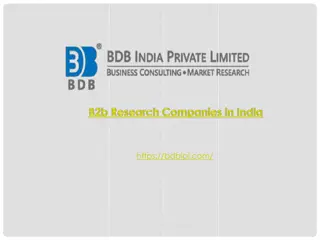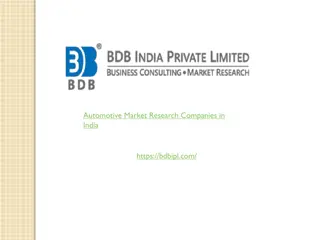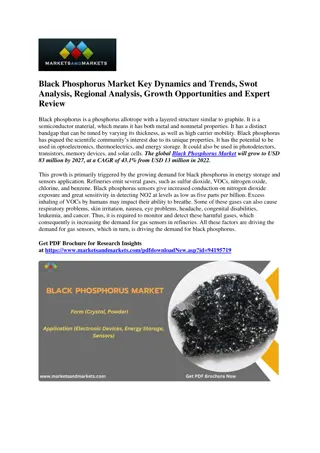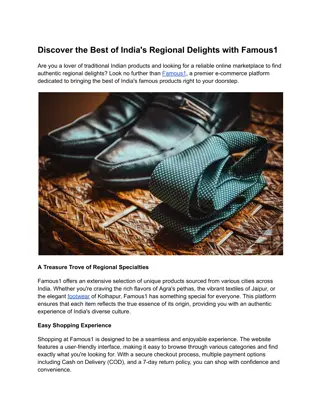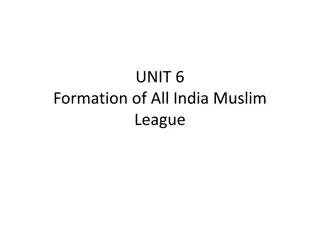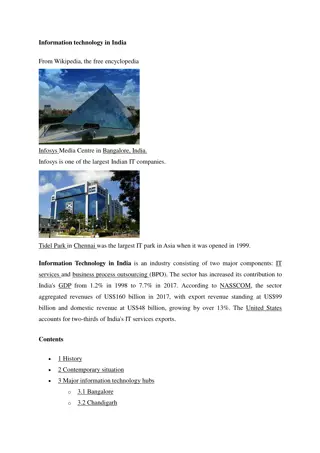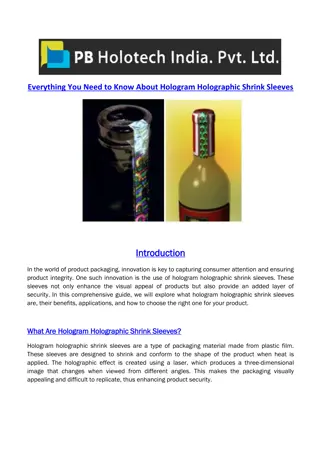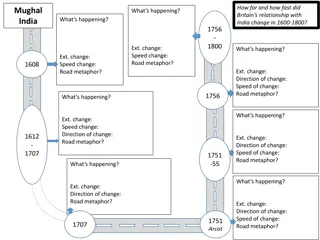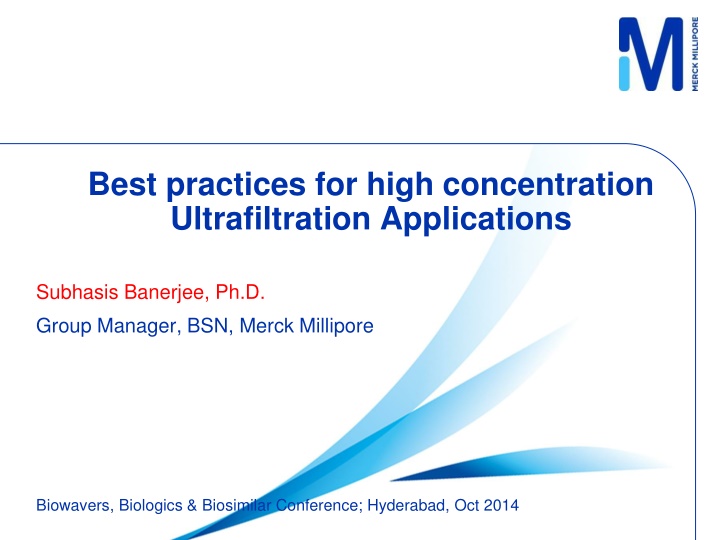
High Concentration Ultrafiltration Applications Overview with Subhasis Banerjee, Ph.D.
Explore best practices for high concentration ultrafiltration applications in biologics with insights from Subhasis Banerjee, Ph.D., covering drivers, challenges, and solutions for processing high protein concentrations. Learn about the importance of high concentration drivers in biologics, subcutaneous injection issues, and challenges with high concentrations of proteins.
Uploaded on | 2 Views
Download Presentation

Please find below an Image/Link to download the presentation.
The content on the website is provided AS IS for your information and personal use only. It may not be sold, licensed, or shared on other websites without obtaining consent from the author. If you encounter any issues during the download, it is possible that the publisher has removed the file from their server.
You are allowed to download the files provided on this website for personal or commercial use, subject to the condition that they are used lawfully. All files are the property of their respective owners.
The content on the website is provided AS IS for your information and personal use only. It may not be sold, licensed, or shared on other websites without obtaining consent from the author.
E N D
Presentation Transcript
Best practices for high concentration Ultrafiltration Applications Subhasis Banerjee, Ph.D. Group Manager, BSN, Merck Millipore Biowavers, Biologics & Biosimilar Conference; Hyderabad, Oct 2014
Overview Driver for high protein concentration (HPC) in Biologics. Challenges in processing HPC using UF. New UF cassette development for HPC applications.
High Concentration Drivers for Biologics High patient doses required for biological products (mAbs): ~1-3mg/kG ( upto 10 mg/kg) Intravenous (IV) infusion traditional delivery method Issues: Infusion side effects, cost, quality of life, patient compliance 3
High Concentration Drivers for Biologics High patient doses required for biological products (mAbs): ~1-3mg/kG ( upto 10 mg/kg) Intravenous (IV) infusion traditional delivery method Issues: Infusion side effects, cost, quality of life, patient compliance Subcutaneous administration (Sub-Q) preferred by patients Ease of Use, savings in time & cost, convenience, mitigate severe after-effects of infusion 4 M.Eisenstein, v29 , # 2, Feb. 2011 Nature Biotech
High Concentration Drivers for Biologics Subcutaneous injection Issues/Requirements Needle phobia and pain of injection 5
High Concentration Drivers for Biologics Subcutaneous injection Issues/Requirements Needle phobia and pain of injection Studies show that increasing injection vol from 0.5 ml to 1 ml increases pain significantly Target injection vol < 1 ml For a 2-3 mg/kg dose, for a 70 kg person 140-210 mg dose; if injectiion vol. needs to be less than 1 ml, we are talking about a protein concentration of > 140-210 g/L Sub-Q injections require high conc. protein formulations 6
Challenges with High Concentration of Proteins Potentially significant changes in solution properties Viscosity mechanical processing, drug delivery Osmotic Pressure max conc in a TFF process Thermodynamic properties (excluded volume, donnan) impurity clearance in diafiltration 7
Challenges with High Concentration of Proteins Viscosity and Osmotic effects may combine to limit the Max achievable concentration in a TFF process Let s see how? 8
Viscosity Effects Viscosity increases non-linearly with concentration Burckbuchler, V., European Journal of Pharmaceutics 2010 9
Viscosity Effects Viscosity increases non-linearly with concentration Varies widely with mAb type for a given concentration 10
Viscosity Effects TFF Processing Pressure drop in a TFF system as viscosity Diafiltration buffer PSystem QR PValve Retentate valve Retentate PR Feed Tank PF PM QF TMP Feed PP Permeate QP P M = + Valve P + System P P TMP P 2 11
Viscosity Effects TFF Processing Pressure drop in a TFF system as viscosity Cassette resistance dominates for a given flow geometry PSystem 12
Viscosity Effects TFF Processing For a given flow, viscosity, cassette resistance determined by geometry: Channel size, screen type V C A Ascreen fine Cscreen coarse Vscreen suspended - High pressure drop - Medium pressure drop - Very Low pressure drop Screen variables Weave pattern, wire diameter, mesh count, mesh opening, overmolding, orientation, etc. DaCosta, A., JMS 1994 13
Viscosity Effects TFF Processing For a given flow, viscosity, cassette resistance determined by geometry: Channel size, screen type V C A A-Screen C- Screen V-Screen @ 15L/min/m2 V-Screen 14
Osmotic Pressure Effects TFF Processing Osmotic pressure resulting from concentration difference between membrane wall (Cw) and permeate (Cf 0) ( ) k = Cb J L TMP p Feed Retentate Cw membrane Cf TMP Permeate ( ) = J L TMP Osmotic .... Pressure Model p Applied TMP must be > osmotic pressure to force permeate flow Modules and equipment limit maximum TMP 15
How do high viscosity & osmotic pressure affect TFF processing? Permeate flux through a TFF membrane: ( ) = J L TMP p Is determined by excess TMP over osmotic pressure C Depends on mass transfer coeff (flow, geom) and solute conc. gel = J kln( ) C bulk 16
Example Permeate flux vs Concentration for Tight and Open screens We notice that V-screen Cgel > C-Screen Cgel. Open Tight 398 g/L 242 g/L IVIG Concentration PLCHK 0.1m2 Pellicon 2 50 J = 19.3Ln(242/C) R2 = 0.9593 45 C 5LMM Permeate Flux (LMH) 40 35 V 9LMM 30 25 20 15 J = 9.2Ln(398/C) R2 = 0.895 10 5 0 1 10 100 1000 IVIG Concentration (g/L) 17
Inference High final concentrations achievable at lower feed flows and more open feed channel! Develop a more optimum feed channel for high conc (high viscosity) apps Existing C-Screen too tight, V-Screen possibly too open optimum probably in- between Trade-off: lower permeate flux, larger membrane area 18
High Viscosity Screen/Cassette Development Product need: What is the right screen size? What viscosity do we target? 19
Viscosity Target Estimation High viscosity impacts the ability to load and deliver drug from the syringe 8Q L F = A syringe 4 needle R At a given force, flow (Q) is proportional to fourth power of needle radius Inversely to viscosity If needle is too narrow Require High force or Slow flow Unreasonable time for patient to hold PFS during injection >20 sec 20
Viscosity Target Estimation High viscosity impacts the ability to load and deliver drug from the syringe Shire et al, J. of Pharm Sci, V93, NO. 6, JUNE 2004 Fig A: Viscosity (solid line, open circles) and syringe (27 gauge) loading time (dashed line, solid triangles) of a monoclonal antibody as a function of concentration. 21
Viscosity Target Estimation High viscosity impacts the ability to load and deliver drug from the syringe Manual injection force limited to 10-30 N Typical sub-Q needle size range between 25-27 gauge* 30 Gauge 27 Gauge SC delivery limited by - Viscosity ~30cp - Needle Size - Injection Flowrate 26 Gauge Burckbuchler, V., European Journal of Pharmaceutics 2010 "http://en.wikipedia.org/wiki/Nee dle_gauge_comparison_chart" 22 *http://www.bccdc.ca/NR/rdonlyres/24C36473-261A-4FBD-8A41-444B3520DB64/0/ SectionIV_AdministrationofBiologicalProducts_June2012_.pdf
High Viscosity (Protein Conc) TFF Cassette V C A Develop the Just Right Size Too tight for HC Apps Too Open for HC Apps 24
The HV TFF Cassette Preview Pressure drop vs Concentration & Xflow: At 8 L/min/m2 cross flow rate HV TFF Cassette Cross Flow Effects 140.0 70 V Screen 120.0 8 LMM 6 LMM 4 LMM C Screen 60 High Viscosity TFF 100.0 50 80.0 dP (psi) dP (psi) 40 60.0 30 20 40.0 10 20.0 0 0.0 0 40 80 120 160 200 240 0.0 50.0 100.0 150.0 200.0 250.0 Concentration of BgG (g/L) Concentration of BgG (g/L) HV Cassette screen ( D Screen) P ~ 50% of C screen P P=K JF 25
The HV TFF Cassette Preview Flux vs. Concentration & Xflow: HV TFF Cassette Cross Flow Effects At 8 L/min/m2 cross flow rate 45 60.0 40 8LMM 6LMM 4LMM V Screen 35 C Screen 50.0 30 Flux (LHM) High Viscosity TFF 25 40.0 20 Flux (LMH) 15 10 30.0 5 0 20.0 10 100 1000 Concentration of BgG (g/L) 10.0 0.0 10.0 100.0 1000.0 Concentration of BgG (g/L) HV Cassette (D) screen J~ 80% of C screen J 26
HV Cassette Performance Summary Product Attribute Performance Outcome Final viscosity > 25 cP Feed channel P-water 2-6 psi 50% of C screen Feed channel P-mAb at 25 cP 150% of V-screen Mass transfer k* 80% of C-screen 0.5 X of V-Screen 1.2 X of C-Screen Membrane Area Mass transfer coefficient is compared at the same cross flow rate. At 8 L/min/m2 cross flow rate Enables the TFF process to optimally get to high protein concentrations required for Subcutaneous drug delivery 27
Thank You! Acknowledgements Herb Lutz Joseph Parrella Bala Raghunath 28


